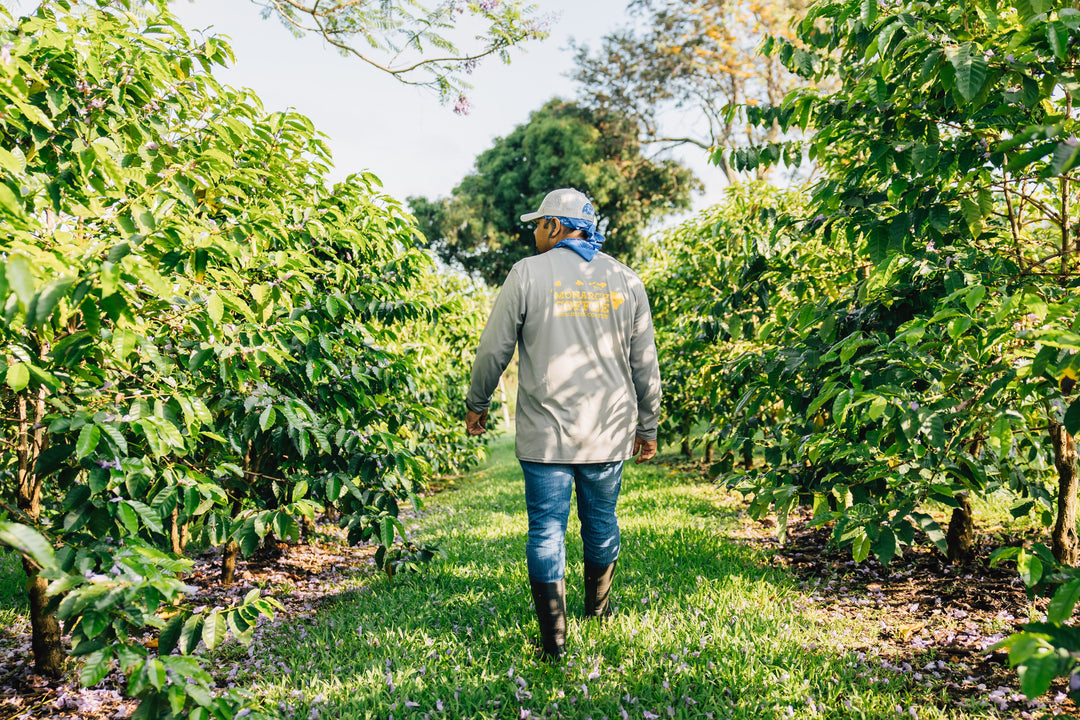A Visit to Amparo Pajoy
Los Alpes
In September, Oliver, Becky and Patrick traveled to Colombia to visit a number of our producers and spend time with our green coffee importers/exporters at Caravela. It’s important for us to visit our producers throughout the year to maintain and grow our relationships as well as cup coffees with the Caravela team. This builds trust with our coffee farmers and gives us the necessary opportunity to stay in calibration with our importing partners. We need to be sure that when Caravela cups and scores a coffee an 88, Olympia Coffee scores that same coffee an 88 at our cupping lab in Downtown Olympia. It was an eye-opening experience into the complexities of our sourcing program and how unique and special it is that we go back year after year to visit our producers.
Unless you yourself travel these same roads from farm, to warehouse, to airport and back home, it is difficult to describe how far coffee travels to arrive our stores. While it may seem easy enough to fly to any major city around the world, these farms are often located high up on steep slopes of the mountains above the rural towns and villages in coffee producing countries. The sheer angle at which coffee trees are planted is mindblowing. In some areas a 45 degree angle is quite generous and it seems the only spot one could find solid footing is at the base of the trees. On top of that, imagine you’re carrying a bucket around your waist ascending and descending these slopes holding 20 to 30 pounds of coffee cherries. Much respect is due for the feet and hands that begin the journey of coffee from a seed in a cherry to our cup. One of these producers in particular has a special place in our hearts.
Amparo Pajoy
Los Alpes| 1700masl
La Plata, Huila | 1050masl
Amparo Pajoy’s farm is located on the mountainside overlooking the town of La Plata, Huila. As you may or may not expect, the road to there was not paved cement. It twisted and turned as we slowly made our way up, passing various houses, streams and motorcycles through the dense foliage. One such plant looked very similar to bamboo and is called “guadua,” which is used throughout the area as a versatile building material. After about 40 minutes we reached a peak near a neighbor’s home and parked the car. However, the next road was not wide enough for our vehicle. It's used for walking, horses and motorcycles so we set out on foot. Along the way we passed three or four neighbor’s houses and a section that was under renovation by the community. Amparo’s home was actually the last one on this path and this is when it hits you. The roads you just walked down and drove up is the same one the coffee travels to reach the warehouse back in La Plata. Thousands and thousands of pounds of coffee.
We were greeted graciously and sat down to introduce ourselves, catch up, check in and drink fresh juice! On this trip we had the honor to tell Amparo in person that she will be receiving fixed prices from us for the coffee she produces. This is our commitment to her and her commitment to us by producing amazing coffee year after year and always looking for ways to improve not only her crops but the lives of the people around her. #fairforall
Following the good news we took a brief tour of her wet mill, built with guadua, located right outside her house. We discussed various topics surrounding their processing techniques and listened to their successes and the challenges they face. After taking in the view and fresh air we sat down to a delicious homemade lunch of soup, seasoned rice, stewed chicken, fried potatoes and a jello dessert. After replenishing some energy we headed up to see the coffee trees situated on the mountainside directly behind the house. Currently, she has Caturra and Colombia varieties with plans to plant new varietals and increased production in the future. Alongside coffee, they plant various other crops including corn, bananas and frijoles (beans), which grew on trellises made of stumped coffee tree trunks distributed throughout the orchards. This is awesome because beans are legumes and legumes convert atmospheric nitrogen into nitrates in the soil! Coffee trees love nitrogen! Go Amparo! Following the tour of the coffee orchards we said our goodbyes and started our trek back down to La Plata for dinner and some much needed sleep.
The relationship between Olympia Coffee and Amparo Pajoy is not the norm for how coffee is traded throughout the globe. When Amparo began her farm over 5 years ago, Olympia was there to help her build an equitable and sustainable life for her family.
By working with her year after year we are able to work directly with a producer who shares the same mission, vision and values of the company and we help to relieve the stress of economic uncertainty that comes from producing an agricultural product whose value is subject to it’s quality and buyers from other countries.
One example of Amparo’s commitment determination, excellence, feedback and teamwork is by submitting her coffees to the Colombian Cup of Excellence. Often referred to as CoE, the Cup of Excellence is held in various producing countries whose purpose is to highlight and reward the best coffee producers of that country each year. It is a rigorous judging process where coffee is evaluated by highly trained tasters from all over the world. This year, we are proud to see that Amparo Pajoy placed 16th overall in Colombia for 2018!!! 16th in the third largest coffee producing country in the world!!! We can’t wait to get our hands on this coffee and what the future holds as we continue to grow, learn and thrive with our amazing coffee producers.




